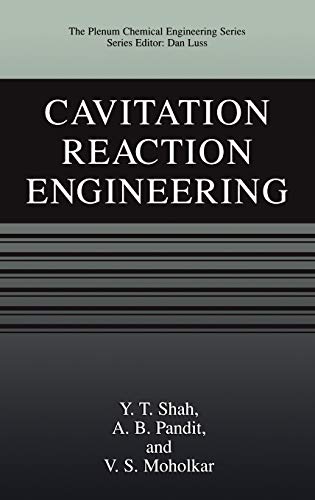Items related to Cavitation Reaction Engineering (The Plenum Chemical...

"synopsis" may belong to another edition of this title.
"About this title" may belong to another edition of this title.
- PublisherSpringer
- Publication date1999
- ISBN 10 0306461412
- ISBN 13 9780306461415
- BindingHardcover
- Number of pages371
Buy New
Learn more about this copy
Shipping:
FREE
Within U.S.A.
Top Search Results from the AbeBooks Marketplace
Cavitation Reaction Engineering (The Plenum Chemical Engineering Series) by Shah, Y.T., Pandit, A.B., Moholkar, V.S. [Hardcover ]
Book Description Hardcover. Condition: new. Seller Inventory # 9780306461415
Cavitation Reaction Engineering
Book Description Condition: New. PRINT ON DEMAND Book; New; Fast Shipping from the UK. No. book. Seller Inventory # ria9780306461415_lsuk
Cavitation Reaction Engineering
Book Description Gebunden. Condition: New. Seller Inventory # 5902954
Cavitation Reaction Engineering (The Plenum Chemical Engineering Series)
Book Description Condition: New. Seller Inventory # ABLIING23Feb2215580099893
Cavitation Reaction Engineering
Book Description Buch. Condition: Neu. This item is printed on demand - it takes 3-4 days longer - Neuware -The literature on cavitation chemistry is ripe with conjectures, possibilities, heuris tic arguments, and intelligent guesses. The chemical effects of cavitation have been explained by means of many theories, consisting of empirical constants, adjustable parameters, and the like. The chemists working with cavitation chemistry agree that the phenomenon is very complex and system specific. Mathematicians and physi cists have offered partial solutions to the observed phenomena on the basis of cavitation parameters, whereas chemists have attempted explanations based on the modes of reaction and the detection of intermediate chemical species. Nevertheless, no one has been able to formulate a unified theme, however crude, for its effects on the basis of the known parameters, such as cavitation and transient chemistry involving extremely high temperatures of nanosecond durations. When one surveys the literature on cavitation-assisted reactions, it is clear that the approach so far has been 'Edisonian' in nature. While a large number of reactions have showed either enhanced yields or reduced reaction times, many reactions have remained unaffected in the presence of cavitation. The success or failure of cavitation reactions ultimately depends on the collapse of the cavity. Cavitation chemistry is based on the principles of the formation of small transient cavities, their growth and implosion, which produce chemical reactions caused by the generation of extreme pressures and temperatures and a high degree of micro turbulence. 376 pp. Englisch. Seller Inventory # 9780306461415
Cavitation Reaction Engineering
Book Description Buch. Condition: Neu. Druck auf Anfrage Neuware - Printed after ordering - The literature on cavitation chemistry is ripe with conjectures, possibilities, heuris tic arguments, and intelligent guesses. The chemical effects of cavitation have been explained by means of many theories, consisting of empirical constants, adjustable parameters, and the like. The chemists working with cavitation chemistry agree that the phenomenon is very complex and system specific. Mathematicians and physi cists have offered partial solutions to the observed phenomena on the basis of cavitation parameters, whereas chemists have attempted explanations based on the modes of reaction and the detection of intermediate chemical species. Nevertheless, no one has been able to formulate a unified theme, however crude, for its effects on the basis of the known parameters, such as cavitation and transient chemistry involving extremely high temperatures of nanosecond durations. When one surveys the literature on cavitation-assisted reactions, it is clear that the approach so far has been 'Edisonian' in nature. While a large number of reactions have showed either enhanced yields or reduced reaction times, many reactions have remained unaffected in the presence of cavitation. The success or failure of cavitation reactions ultimately depends on the collapse of the cavity. Cavitation chemistry is based on the principles of the formation of small transient cavities, their growth and implosion, which produce chemical reactions caused by the generation of extreme pressures and temperatures and a high degree of micro turbulence. Seller Inventory # 9780306461415

